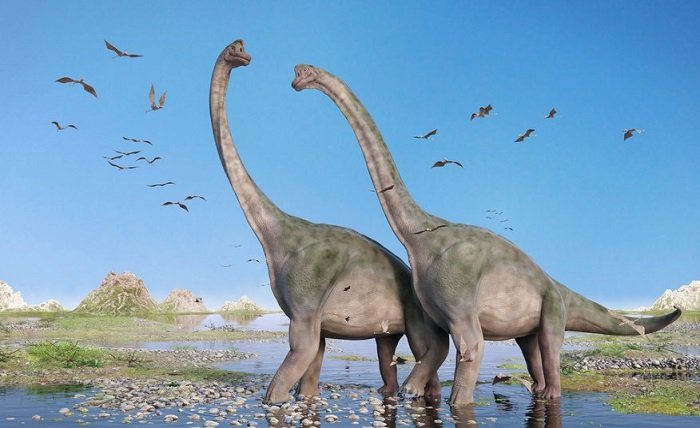The Majestic World of Long Neck Dinosaurs: Unveiling the Giants of the Mesozoic Era

Long neck dinosaurs, often known as sauropods, were some of the largest creatures to ever walk the Earth. These colossal beings roamed various parts of the planet during the Mesozoic era, captivating anyone who dares to imagine their grandeur. From the well-known Brachiosaurus to the towering Diplodocus, long neck dinosaurs exemplify prehistoric life’s remarkable diversity and adaptation.
The Anatomy of Long Neck Dinosaurs
Understanding the anatomy of long neck dinosaurs provides insights into their daily lives and survival strategies. The distinctive feature of these dinosaurs, their elongated necks, consisted of vertebrae that were larger and more air-filled than those of other dinosaurs, reducing weight while maintaining strength. This adaptation allowed them to browse for food over large areas, reaching high into trees or across to different plants, which was crucial for their sustenance.
Evolutionary Journey of Long Neck Dinosaurs
The evolutionary journey of long neck dinosaurs began in the late Triassic period, with early forms like Plateosaurus demonstrating moderate neck lengths. As the Jurassic period progressed, the necks of these dinosaurs evolved to become longer, a trait that peaked during the Late Jurassic with species like Apatosaurus and Brachiosaurus. This evolution highlights the dynamic changes in ecosystems and available flora during these periods.
Habitat and Ecological Role
The habitats of long neck dinosaurs were as varied as their species. These giants commonly frequented lush floodplains and dense forests, which provided both the vast quantities of vegetation they needed to sustain their enormous bodies and protection from predators. Their role in the ecosystem was pivotal, as they helped to shape the vegetation structure and influenced the ecological dynamics through their feeding habits.
The Daily Life of a Long Neck Dinosaur
The daily life of a long neck dinosaur revolved around two main activities: eating and moving. Given their enormous energy needs, these dinosaurs likely spent a significant part of their day feeding on the abundant plant life of the Mesozoic era. Their movement, while slow, would have been driven by the need to find fresh feeding grounds and possibly water sources.
Long Neck Dinosaurs and Their Social Behavior
While there is much to speculate about the social behavior of long neck dinosaurs, evidence suggests that some species, like the Diplodocus, might have lived in herds. Living in groups would have provided benefits such as protection from predators and assistance in caring for young. Fossilized trackways in places like the United States even suggest communal pathways used by these dinosaurs.
Famous Long Neck Dinosaurs: A Closer Look at Brachiosaurus and Diplodocus
Among the most iconic long neck dinosaurs are Brachiosaurus and Diplodocus. The Brachiosaurus, known for its relatively shorter tail and taller stance, is often depicted reaching into high trees to feed. In contrast, Diplodocus had a much longer tail and a horizontal body posture, adapted to sweeping across wide areas to gather food.
Long Neck Dinosaurs in Popular Culture
Long neck dinosaurs hold a prominent place in popular culture, often featured in films, cartoons, and literature. Their impressive size and distinctive shape capture the imagination, making them stars of the dinosaur world. From museum exhibits to cinematic appearances, these dinosaurs continue to fascinate people of all ages.
The Extinction of Long Neck Dinosaurs
The extinction of long neck dinosaurs, like many other dinosaur groups, occurred at the end of the Cretaceous period, approximately 65 million years ago. This mass extinction event, likely caused by a combination of volcanic activity and a catastrophic asteroid impact, led to the sudden decline of these magnificent creatures, along with 75% of Earth’s species.
Long Neck Dinosaur Fossils: Discoveries and Research
The study of long neck dinosaur fossils provides valuable information about their lives and the environments they inhabited. Notable discoveries include well-preserved specimens that offer clues about their physiology, such as heart placement and respiratory systems, which help scientists understand how such massive animals could have lived.
Modern Science and Long Neck Dinosaur Legacy
Modern scientific techniques, including computer simulations and 3D modeling, have advanced our understanding of long neck dinosaurs. These technologies allow researchers to study locomotion and behavior, offering more accurate depictions of how these dinosaurs moved and interacted with their environments.
Conservation of Long Neck Dinosaur Fossils
The conservation of long neck dinosaur fossils is crucial for ongoing and future scientific research and public education. Ensuring these fossils are preserved requires international cooperation and sustainable practices to protect these sites from natural and human-induced threats.
Conclusion
Long neck dinosaurs, or sauropods, represent some of the most awe-inspiring creatures that have ever existed. Their massive size, unique adaptations, and evolutionary history offer a window into a past world vastly different from our own. As we continue to discover and study their fossils, the legacy of these magnificent dinosaurs provides endless fascination and learning opportunities.
FAQs
1. What did long neck dinosaurs eat? Long neck dinosaurs were herbivores, primarily feeding on conifers, cycads, and ferns prevalent during the Mesozoic era.
2. How long were the necks of long neck dinosaurs? The necks could reach lengths of up to 50 feet, depending on the species, such as in the case of the Mamenchisaurus.
3. Did long neck dinosaurs have any predators? Despite their size, young and weaker members of these species could have been preyed upon by large carnivorous dinosaurs like Allosaurus and Tyrannosaurus.
4. How did long neck dinosaurs support their massive bodies? They had massive legs, much like pillars, and their vertebrae were filled with air sacs which made them lighter and more manageable.
5. Where can I see long neck dinosaur fossils? Major museums around the world, including the Smithsonian in Washington, D.C., and the Natural History Museum in London, house impressive long neck dinosaur exhibits.





